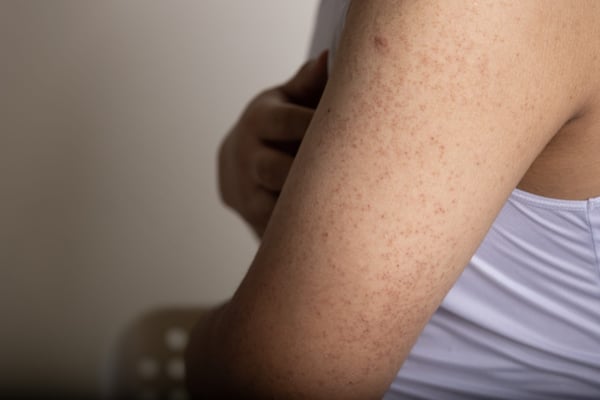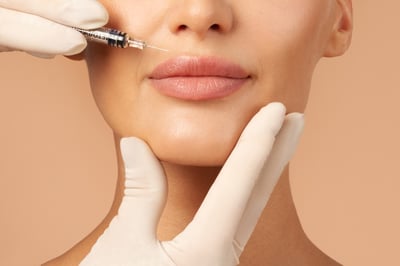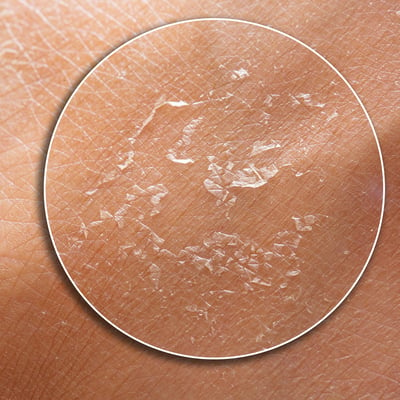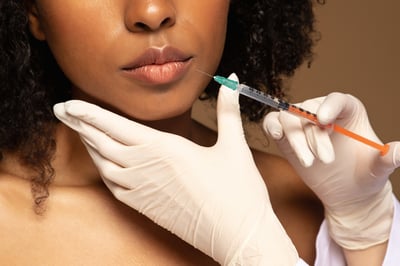
It’s warm-weather season, and you’re sliding into your favorite tank top, ready to show off your arms. Then your eyes catch those little, rough bumps on your upper arms, and suddenly your confidence wavers. Don’t worry; you’re in good company. Those tiny, harmless lumps are called keratosis pilaris, though you’ve probably heard them referred to more casually as “chicken skin.”
Keratosis pilaris is so common that dermatologists sometimes joke that it is its own a skin type. Millions of people (kids, teens, and adults alike) have it, yet it remains one of those things no one really talks about. Instead, many of us quietly Google phrases like “gooseflesh on arms” or “rough skin upper arms won’t go away” late at night, hoping for answers.
The good news is that this common condition is not an infection, it’s not contagious, and it’s not something you caused. But that doesn’t mean it can’t feel frustrating or embarrassing. So let’s look at what causes so-called chicken skin and how you either minimize it – or embrace it!
What exactly is keratosis pilaris?
Often shortened to KP, keratosis pilaris is a completely harmless skin condition that creates small, rough bumps that feel a bit like permanent goosebumps. In reality, keratosis pilaris is a fancy way of saying you have follicular bumps: tiny, hard plugs in the hair follicles that make your skin feel rough. These little bumps are usually white or flesh-colored, sometimes with a pinkish halo. They love to hang out on the backs of your arms, thighs, and even cheeks. Some people notice them more in winter when the air is dry, while others see them year-round.
Before we dive into solutions, let’s clear up some common confusion. Not all bumpy skin is keratosis pilaris, and distinguishing between similar-looking conditions can save you from unnecessary worry (and ineffective treatments).
Real KP bumps are typically small, uniform, and feel rough to the touch. They don’t usually itch intensely, though they might feel slightly irritated sometimes. If your bumps are painful, rapidly changing, intensely itchy, or accompanied by other symptoms, you might be dealing with something else entirely, like contact dermatitis, folliculitis, or even just irritation from a new laundry detergent.
The key difference? KP is consistent and persistent. It doesn’t flare up dramatically and then disappear. It’s more like that reliable friend who’s always there, whether you want them or not.
Unlike some of these other skin issues, KP isn’t actually a skin “problem” that needs fixing. It’s more like having brown eyes or curly hair – just another variation in the beautiful spectrum of human skin types.
The science behind KP
Here’s the quick science-y part: KP is caused by a buildup of keratin, the same protein that makes up your hair and nails. In people with KP, keratin overproduces and clogs the hair follicle, creating that little plug you feel as a bump.
No one knows exactly why some people’s skin likes to hoard keratin, but genetics play a big role. If your mom, dad, or siblings are prone to chicken skin, chances are you will be too. KP is also more common in people with eczema, asthma, or allergies, because skin barrier quirks tend to travel in packs.
It’s important to understand that keratosis polaris is not your fault, and it’s not preventable. Scrubbing harder in the shower won’t get rid of it (in fact, that might make it worse). This isn’t about dirt or “bad skin care habits.” It’s just your skin being… itself!
Do you have to treat it?
Nope! Keratosis pilaris is not broken skin that needs repairing. It’s simply a variation of normal human skin, like freckles or dimples. If your bumpy arms don’t bother you, there’s absolutely no medical reason to treat them.
The decision to pursue treatment should be entirely based on your own comfort level and preferences. Some people find that their KP makes them feel self-conscious in sleeveless tops or shorts, while others barely notice it. Both reactions are completely valid.
For parents wondering about their children’s rough skin, rest assured that KP is incredibly common in kids and often improves on its own as they get older. Many children outgrow their bumpy chicken skin entirely by adulthood.
Skincare for keratosis pilaris
If you do want to reduce your KP, there are a few things you can add to your skincare regimen. The tricky thing about keratosis pilaris is that it can’t be permanently “cured.” Treatments help manage it, but if you stop, the bumps often return. That said, the right routine can make a big difference
1. Gentle cleansing. Choose a mild body wash instead of anything harsh or drying. Sulfate-heavy cleansers can strip natural oils and make the bumps more noticeable.
2. Gentle exfoliation. Skip the harsh scrubs and loofahs (those can irritate skin). Instead, look for exfoliants with mild acids like:
- Lactic acid: great for softening and hydrating rough patches.
- Urea: helps break down keratin plugs and keeps skin moisturized.
- Salicylic acid: a beta-hydroxy acid that exfoliates inside the follicle.
These ingredients work by loosening that keratin buildup, giving your skin a smoother texture over time. These exfoliants are available in products you can find in the skincare section at the drugstore – just check the ingredients. For more persistent cases, dermatologists might recommend prescription retinoids or stronger chemical exfoliants. These can be particularly helpful for reducing the appearance of bumps and smoothing skin texture over time.
3. ABM (always be moisturizing). Dryness makes KP look worse, so a thick, fragrance-free moisturizer is your best friend. Apply it right after showering to lock in hydration. Think of it as giving your skin a tall glass of water.
For a one-two punch, try a cream or serum that contains hyaluronic acid. Hyaluronic acid is a humectant, which means it pulls water into the skin. When combined with exfoliating ingredients like lactic acid, it helps keep skin plump, hydrated, and smoother-looking. KP patients have reported a noticeable reduction in redness and reduction in rough patches when using hyaluronic acid regularly as part of their skincare routine.
4. Be patient. KP doesn’t improve overnight. It may take weeks (sometimes months) of consistent care following steps 1-3 before you notice smoother skin. The key is sticking with it.
Can the dermatologist help?
If you’ve already tried the lotions and potions aisle and still feel like your bumps are hanging on for dear life, dermatologists have a few newer tricks and advancements in treatment up their sleeves. In addition to providing prescription-strength options for exfoliation and moisturizing, many practices offer other in-office treatments for reducing redness and bumps:
Microdermabrasion or chemical peels: Dermatologists can recommend gentle chemical peels or microdermabrasion. Both treatments work by exfoliating the outer layer of skin more effectively than at-home products, helping to smooth out the rough texture of keratosis pilaris. While they won’t make KP disappear forever, they can give the skin a softer feel and more even appearance when done as part of a series.
Laser therapy: For stubborn keratosis pilaris (especially the red, inflamed kind), certain cosmetic treatments such as pulsed dye and fractional CO2 lasers can target redness and improve texture over time. In fact, a recent study found that ND YAG lasers, which are commonly used to improve skin pigment issues, are particularly effective for safely reducing rough skin associated with keratosis pilaris.
These treatments aren’t usually the first stop (and they can be pricey), but they’re an option if KP is really bothering you.
While effective, these advanced treatments aren’t necessary for everyone, and many people are perfectly happy managing KP with simple at-home routines. But if you’re curious, a dermatologist can walk you through the options and help decide what’s worth trying for your skin.
To learn more about all the options available to you, find a Forefront location near you today.





